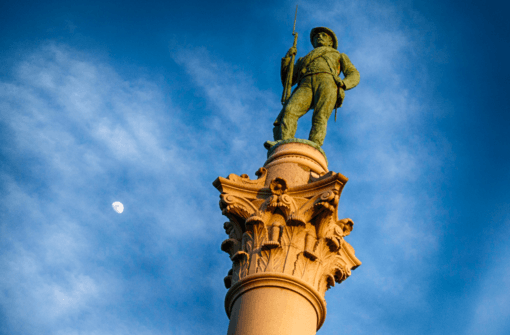
Photo by Mobilus In Mobili | CC BY 2.0
The images—of hundreds of angry young white men bearing tiki torches brightening up the night, marching with discipline bare-faced and proud, chanting “Jews will not replace us!”—are terrifying. The ability of the organizers of the “Unite the Right” demonstration to produce such a spectacle, on the University of Virginia campus, ostensibly to protest the removal of a statue of Gen. Robert E. Lee from a city park, was quite amazing. Suddenly “white nationalism” (a term used to embrace both KKK and neo-Nazi factions) is a matter for urgent discussion. And the issue of Confederate statues everywhere has to be addressed more urgently.
The homicidal attack by a neo-Nazi on an antifascist protestor, praised by one of the fascist organizers (predicting more deaths) raises the prospect of bloody street battles. (They will perhaps be called the Statue Battles.)
In this context, the president of the U.S.A. felt obliged to blurt of in a news conference Aug. 15 that there had been “many fine people” at the demonstration to protest the removal of the statue. He implicitly endorsed the cause of the preservation of Confederate monuments, asking rhetorically if the removal of monuments to Lee and Stonewall Jackson will lead to the toppling of those to George Washington and Thomas Jefferson. He averred that there were “many sides” at fault for the violence in Charlottesville, implicitly acquitting the nationalists, who were delighted with his words.
The corporate media, which had backed off a bit on its effort to destroy the administration through “Russian collusion” charges, had already shifted to a strategy of attacking Trump’s crazy tweets as evidence for an unhinged personality unfit for his office. Now suddenly every indication of racism in Trump’s past (the Central Park Five ad in 1989, the “birther” slander campaign, the rejection of the integrity of a Mexican-American judge, etc.) is rehashed. He is depicted as a virtual Klan and Nazi sympathizer, or at least a politician courting that base. Magazine covers here and around the world showing him as a Klansman (Time, New Yorker, The Economist, Der Spiegel), are themselves news.
Trump’s appointed advisory councils on manufacturing, strategy and policy, and digital economy board have dissolved themselves. The fricking Joint Chiefs of Staff have taken the rare step of implicitly condemning his remarks. The British Prime Minister had to comment.
You might think: it doesn’t make sense for Trump coddle the “alt-right.” The combined strength of Nazis and Klansmen is surely under 10,000 nationally. There’s no need to cultivate them; indeed to do so could be politically suicidal. Chief of staff John Kelly is surely telling Trump this. And this is why, I think, Steve Bannon is out. He’s been baggage since Saturday Night Live started depicting him as the Grim Reaper in February. He’s been useful, but now will be more useful on the outside making sure the alt-right remains strategically aligned with Trump while understanding his need to say bad things about them sometimes.
But the regime is in deep crisis, much deeper than last week. Republican Senators are aghast. This guy could blow it all with his tweets and unpredictable departures from staff-approved script. The nation turns its lonely eyes to…Pence.
I have not been among those denouncing the Trump administration as “fascist.” This is because I think that term should be applied with care, not just employed as an epithet as it often is. Every spring I teach my students about Japan in the 1930s and early 40s, and raise the question: was the Japanese state fascist? Actually, that’s a complicated question. Surely there was a fascist movement, as Maruyama Masao discussed in his work. Is the U.S. state fascist at present? That’s not complicated. No. At least not yet, and I have great faith in the level of political awareness and energy of our youth (however nauseated I am by the sight of college-age white men marching in hundreds for hate, and fearful I am of the possibility their movement could grow) to prevent the emergence of such a state.
But the fact that the mainstream press and political establishment are so pressuring Trump to distance himself from fascism—saying in essence, “Don’t you realize how outrageous your words were?”—and he’s responding by doubling down, defying everybody including his closest allies to assert his right to express his take on Charlottesville (and then move on)—is troubling.
The problem is not that a fascist regime currently reigns or is imminent but that a solipsistic buffoon unable to amass a stable staff around him (one able to protect him from the consequences of his mouth, including the ramifications of statements that strike most as oddly pro-Nazi) is injecting burning hope into the hearts of those tiki torch bearers.
“I’ve condemned many different groups, but not all of those people were neo-Nazis, believe me. Not all of those people were white supremacists by any stretch. Those people were also there, because they wanted to protest the taking down of a statue Robert E. Lee. So – excuse me – and you take a look at some of the groups and you see, and you’d know it if you were honest reporters, which in many cases you’re not. Many of those people were there to protest the taking down of the statue of Robert E. Lee. So this week, it’s Robert E. Lee, I noticed that Stonewall Jackson’s coming down. I wonder, is it George Washington next week? And is it Thomas Jefferson the week after. You know, you really do have to ask yourself, where does it stop?”
That moment in that press conference probably sealed the buffoon’s political doom, although it has sharpened political contradictions to the delight of Bannon, and of David Duke. Big alt-right event planned for the Boston Common this afternoon. Will be interesting to see how, in this my city of thirty years, this movement re-energized by this toxic man succeeds in expanding on its Charlottesville advances.